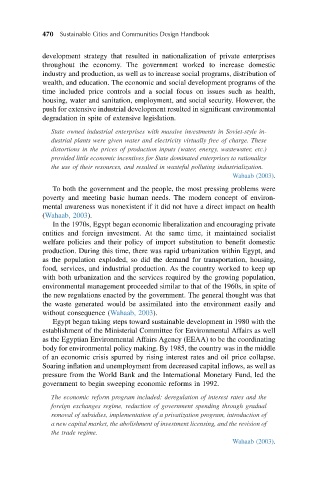Page 500 - Sustainable Cities and Communities Design Handbook
P. 500
470 Sustainable Cities and Communities Design Handbook
development strategy that resulted in nationalization of private enterprises
throughout the economy. The government worked to increase domestic
industry and production, as well as to increase social programs, distribution of
wealth, and education. The economic and social development programs of the
time included price controls and a social focus on issues such as health,
housing, water and sanitation, employment, and social security. However, the
push for extensive industrial development resulted in significant environmental
degradation in spite of extensive legislation.
State owned industrial enterprises with massive investments in Soviet-style in-
dustrial plants were given water and electricity virtually free of charge. These
distortions in the prices of production inputs (water, energy, wastewater, etc.)
provided little economic incentives for State dominated enterprises to rationalize
the use of their resources, and resulted in wasteful polluting industrialization.
Wahaab (2003).
To both the government and the people, the most pressing problems were
poverty and meeting basic human needs. The modern concept of environ-
mental awareness was nonexistent if it did not have a direct impact on health
(Wahaab, 2003).
In the 1970s, Egypt began economic liberalization and encouraging private
entities and foreign investment. At the same time, it maintained socialist
welfare policies and their policy of import substitution to benefit domestic
production. During this time, there was rapid urbanization within Egypt, and
as the population exploded, so did the demand for transportation, housing,
food, services, and industrial production. As the country worked to keep up
with both urbanization and the services required by the growing population,
environmental management proceeded similar to that of the 1960s, in spite of
the new regulations enacted by the government. The general thought was that
the waste generated would be assimilated into the environment easily and
without consequence (Wahaab, 2003).
Egypt began taking steps toward sustainable development in 1980 with the
establishment of the Ministerial Committee for Environmental Affairs as well
as the Egyptian Environmental Affairs Agency (EEAA) to be the coordinating
body for environmental policy making. By 1985, the country was in the middle
of an economic crisis spurred by rising interest rates and oil price collapse.
Soaring inflation and unemployment from decreased capital inflows, as well as
pressure from the World Bank and the International Monetary Fund, led the
government to begin sweeping economic reforms in 1992.
The economic reform program included: deregulation of interest rates and the
foreign exchanges regime, reduction of government spending through gradual
removal of subsidies, implementation of a privatization program, introduction of
a new capital market, the abolishment of investment licensing, and the revision of
the trade regime.
Wahaab (2003).

